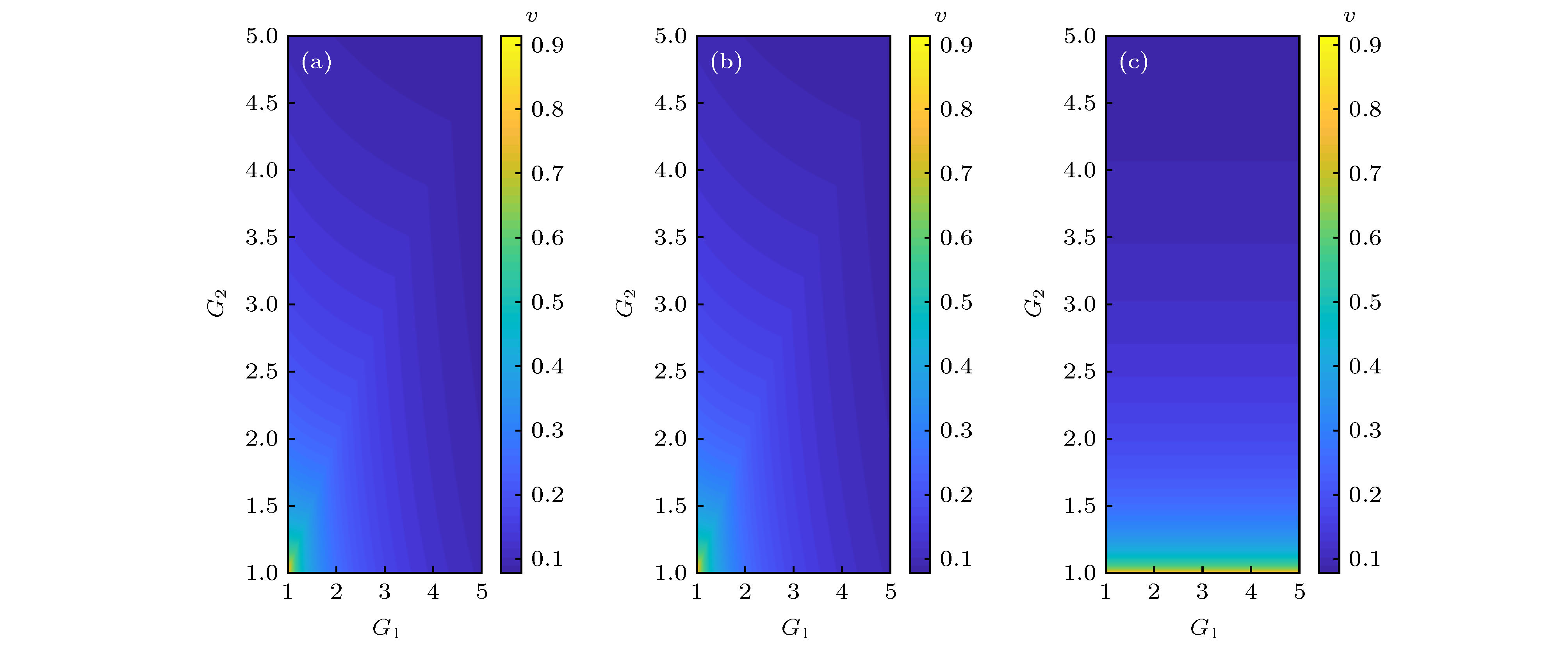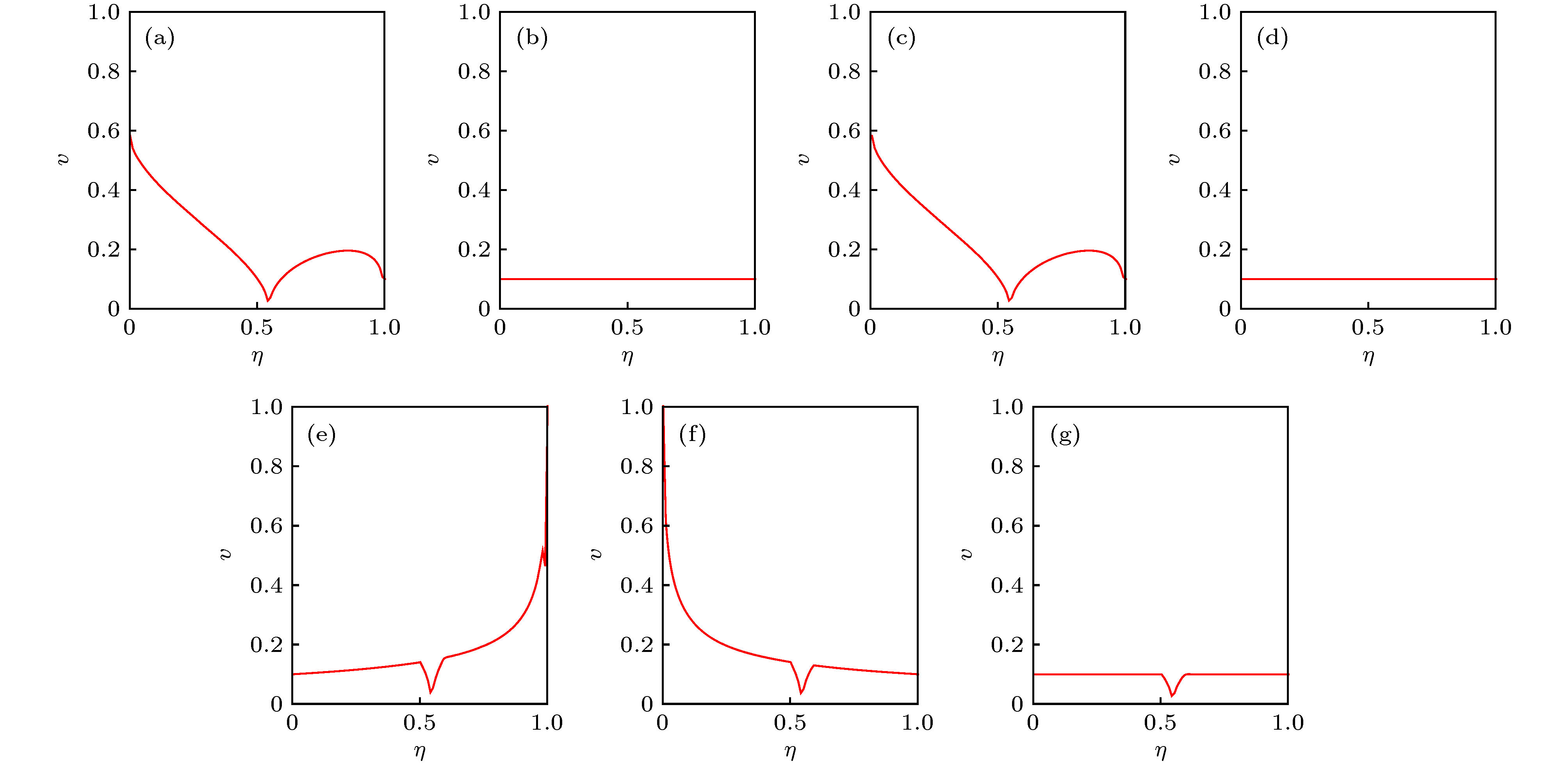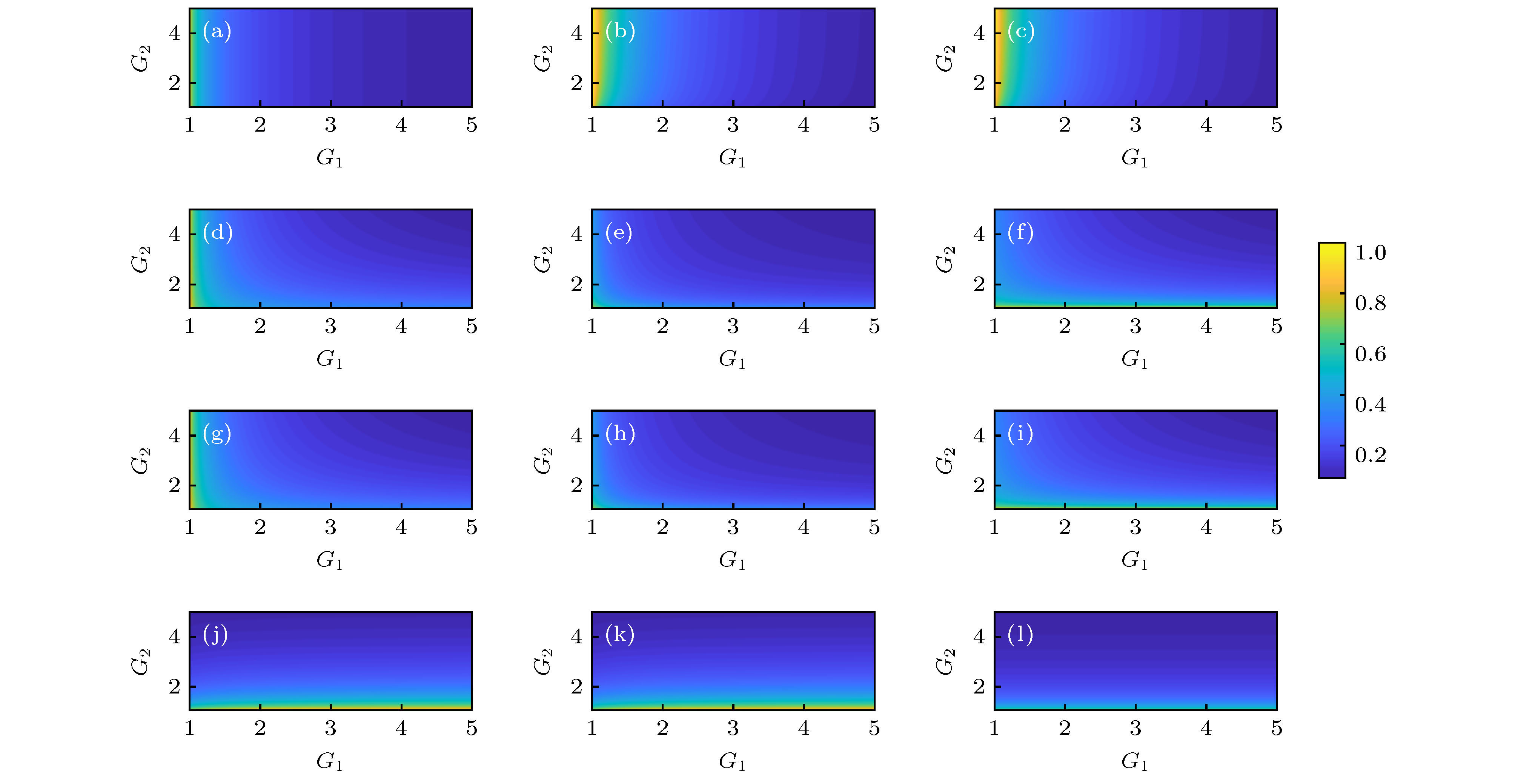-
多组份纠缠是量子信息处理的重要资源, 它的产生通常涉及到许多复杂的线性和非线性过程. 本文从理论上提出了一种利用两个独立的四波混频过程和线性分束器产生真正的四组份纠缠的方案, 其中, 线性分束器的作用是将两个独立的四波混频过程联系起来. 首先应用部分转置正定判据研究了强度增益对四组份纠缠的影响, 结果表明, 在整个增益区域内都存在真正的四组份纠缠, 并且随着强度增益的增加, 纠缠也在增强. 然后研究了线性分束器的透射率对四组份纠缠的影响, 发现只要线性分束器的透射率不为0或1, 该系统也可以产生真正的四组份纠缠. 最后, 通过研究该系统可能存在的三组份纠缠和两组份纠缠来揭示该系统的纠缠结构. 本文理论结果为实验上利用原子系综四波混频过程产生真正的四组份纠缠提供了可靠的方案.As a crucial quantum resource in quantum information processing, multipartite entanglement plays an important role not only in the field of testing basic quantum effects, but also in the applications of quantum network, quantum communication and quantum computing. The generation of multipartite entanglement usually involves many complex linear processes and nonlinear processes. In this paper, we theoretically propose a scheme for generating genuine quadripartite entanglement by linking two independent four-wave mixing (FWM) processes with one linear beam splitter (BS). Here, we use one linear BS to mix the probe beams amplified by two independent FWM processes. We first set the transmissivity of the linear BS to be 0.5 and study the effect of the intensity gain of the system on quadripartite entanglement by applying the positivity under partial transposition (PPT) criterion. The results show that there exists genuine quadripartite entanglement in all gain regions, and the degree of entanglement increases with intensity gain increasing. And then, the dependence of quadripartite entanglement on the transmissivity of the linear BS is studied when the intensity gains of two independent FWM processes are both set to be 3. We find that the transmissivity of the linear BS can affect the entanglement properties of the system. At the same time, we also find that the system can generate genuine quadripartite entanglement when the transmissivity of the linear BS is not equal to 0 or 1. Finally, in order to reveal the entanglement structure of the system, we further investigate the dependence of the possible tripartite entanglement and bipartite entanglement on the intensity gain of the system by using the PPT criterion. The results show that there exists the genuine tripartite entanglement in this system, and the degree of entanglement increases as the intensity gain increases. However, there exists no genuine bipartite entanglement in this system, some of bipartite states are always separable, and the entanglement of the other bipartite states gradually become weak and eventually disappear with the increase of the intensity gain. Our theoretical result provides a simple and reliable scheme for generating genuine quadripartite entanglement by using FWM process in atomic ensemble and linear BS.
-
Keywords:
- multipartite entanglement /
- four-wave mixing /
- linear beam splitter /
- quadripartite entanglement /
- entanglement structure
[1] Greenberger D M, Horne M A, Zeilinger A 1993 Phys. Today 46 22
[2] Lloyd S, Braunstein S 1999 Phys. Rev. Lett. 82 1784
 Google Scholar
Google Scholar
[3] Braunstein S L, van Loock P 2005 Rev. Mod. Phys. 77 513
 Google Scholar
Google Scholar
[4] Kimble H J 2008 Nature 453 1023
 Google Scholar
Google Scholar
[5] Bruβ D, Macchiavello C 2011 Phys. Rev. A 83 052313
 Google Scholar
Google Scholar
[6] Jing J T, Zhang J, Yan Y, Zhao F G, Xie C D, Peng K C 2003 Phys. Rev. Lett. 90 167903
 Google Scholar
Google Scholar
[7] Aoki T, Takei N, Yonezawa H, Wakui K, Hiraoka T, Furusawa A, van Loock P 2003 Phys. Rev. Lett. 91 080404
 Google Scholar
Google Scholar
[8] Yonezawa H, Aoki T, Furasawa A 2004 Nature 431 430
 Google Scholar
Google Scholar
[9] van Loock P, Braunstein S L 2000 Phys. Rev. Lett. 84 3482
 Google Scholar
Google Scholar
[10] Coelho A S, Barbosa F A S, Cassemiro K N, Villar A S, Martinelli M, Nussenzveig P 2009 Science 326 823
 Google Scholar
Google Scholar
[11] Armstrong S, Wang M, Teh R Y, Gong Q, He Q, Janousek J, Bachor H A, Reid M D, Lam P K 2015 Nat. Phys. 11 167
 Google Scholar
Google Scholar
[12] Cassermiro K N, Villar A S 2008 Phys. Rev. A 77 022311
 Google Scholar
Google Scholar
[13] Yokoyama S, Ukai R, Armstrong S C, Sornphiphatphong C, Kaji T, Suzuki S, Yoshikawa J I, Yonezawa H, Menicucci N C, Furusawa A 2013 Nat. Photonics 7 982
 Google Scholar
Google Scholar
[14] Roslund J, De Araujo R M, Jiang S, Fabre C, Treps N 2014 Nat. Photonics 8 109
 Google Scholar
Google Scholar
[15] Gerke S, Sperling J, Vogel W, Cai Y, Roslund J, Treps N, Fabre C 2015 Phys. Rev. Lett. 114 050501
 Google Scholar
Google Scholar
[16] Chen M, Menicucci N C, Pfister O 2014 Phys. Rev. Lett. 112 120505
 Google Scholar
Google Scholar
[17] Qin Z Z, Cao L M, Wang H L, Marino A M, Zhang W P, Jing J T 2014 Phys. Rev. Lett. 113 023602
 Google Scholar
Google Scholar
[18] Cao L M, Qi J, Du J J, Jing J T 2017 Phys. Rev. A 95 023803
 Google Scholar
Google Scholar
[19] Liu S S, Wang H L, Jing J T 2018 Phys. Rev. A 97 043846
 Google Scholar
Google Scholar
[20] Wang W, Cao L M, Lou Y B, Du J J, Jing J T 2018 Appl. Phys. Lett. 112 034101
 Google Scholar
Google Scholar
[21] Cao L M, Wang W, Lou Y B, Du J J, Jing J T 2018 Appl. Phys. Lett. 112 251102
 Google Scholar
Google Scholar
[22] Wang H L, Fabre C, Jing J T 2017 Phys. Rev. A 95 051802
 Google Scholar
Google Scholar
[23] Wang H L, Zheng Z, Wang Y X, Jing J T 2016 Opt. Express 24 23459
 Google Scholar
Google Scholar
[24] Lv S C, Jing J T 2017 Phys. Rev. A 96 043873
 Google Scholar
Google Scholar
[25] Lv S C, Jing J T 2018 Opt. Commun. 424 63
 Google Scholar
Google Scholar
[26] Abdisa G, Ahmed I, Wang X X, Liu Z C, Wang H X, Zhang Y P 2016 Phys. Rev. A 94 023849
 Google Scholar
Google Scholar
[27] Li C B, Jiang Z H, Zhang Y, Zhang Z Y, Wen F, Chen H X, Zhang Y P, Xiao M 2017 Phys. Rev. Appl. 7 014023
 Google Scholar
Google Scholar
[28] Zhang D, Li C B, Zhang Z Y, Zhang Y Q, Zhang Y P, Xiao M 2017 Phys. Rev. A 96 043847
 Google Scholar
Google Scholar
[29] Horodecki R, Horodecki P, Horodecki M, Horodecki K 2009 Rev. Mod. Phys. 81 865
 Google Scholar
Google Scholar
[30] Giedke G, Kraus B, Lewenstein M, Cirac J I 2001 Phys. Rev. Lett. 87 167904
 Google Scholar
Google Scholar
[31] Duan L M, Giedke G, Cirac J I, Zoller P 2000 Phys. Rev. Lett. 84 2722
 Google Scholar
Google Scholar
[32] Serafini A, Adesso G, Illuminati F 2005 Phys. Rev. A 71 032349
 Google Scholar
Google Scholar
[33] Peres A 1996 Phys. Rev. Lett. 77 1413
 Google Scholar
Google Scholar
[34] Simon R 2000 Phys. Rev. Lett. 84 2726
 Google Scholar
Google Scholar
[35] Werner R F, Wolf M M 2001 Phys. Rev. Lett. 86 3658
 Google Scholar
Google Scholar
[36] McCormick C F, Boyer V, Arimondo E, Lett P D 2007 Opt. Lett. 32 178
 Google Scholar
Google Scholar
-
图 1 产生四组份纠缠的简化图及铷-85 D1线的双Λ能级结构 (a) C0和C2是真空态注入, Pr0和Pr2是相干态注入; C1和
$ \rm Pr'_{1} $ 是第一个四波混频过程产生的孪生光束, C3和$ \rm Pr'_{3} $ 是第二个四波混频过程产生的孪生光束; 光束Pr1和Pr3是光束$ \rm Pr'_{1} $ 和$ \rm Pr'_{3} $ 经过线性分束器混合后产生的; (b)铷-85 D1线的双Λ能级结构, Δ和δ分别表示单光子失谐和双光子失谐Fig. 1. A simplified diagram of quadripartite entanglement and an energy level diagram of rubidium-85: (a) C0 and C2 are vacuum states, Pr0 and Pr2 are coherent states; C1 and
$ \rm Pr'_{1} $ are the twin beams generated by the first four-wave mixing process, C3 and$ \rm Pr'_{3} $ are the twin beams generated by the second four-wave mixing process; Pr1 and Pr3 are produced by mixing beams$ \rm Pr'_{1} $ and$ \rm Pr'_{3} $ through a linear beam splitter; (b) the double Λ energy level structure of D1 line in rubidium-85, Δ and δ represent one-photon detuning and two-photon detuning respectively.图 2 四种1 × 3情形的最小辛本征值v, 其为强度增益G1和G2的函数 (a) C1被部分转置; (b) Pr1被部分转置; (c) Pr3被部分转置; (d) C3被部分转置
Fig. 2. The smallest symplectic eigenvalue v of all 1 × 3 scenarios, as a function of the power gains G1 and G2: (a) C1 is partially transposed; (b) Pr1 is partially transposed; (c) Pr3 is partially transposed; (d) C3 is partially transposed.
图 3 三种2 × 2情形的最小辛本征值v, 其为强度增益G1和G2的函数 (a) C1和Pr1被部分转置; (b) C1和Pr3被部分转置; (c) C1和C3被部分转置
Fig. 3. The smallest symplectic eigenvalues v of all 2 × 2 scenarios, as a function of the power gains G1 and G2: (a) C1 and Pr1 arepartially transposed; (b) C1 and Pr3 are partially transposed; (c) C1 and C3 are partially transposed.
图 4 线性分束器的透射率η对四组份态的最小辛本征值v的影响 (a) C1被部分转置; (b) Pr1被部分转置; (c) Pr3被部分转置; (d) C3被部分转置; (e) C1和Pr1被部分转置; (f) C1和Pr3被部分转置; (g) C1和C3被部分转置
Fig. 4. Effect of the transmissivity of the linear beam splitter on the quadripartite entanglement of the system: (a) C1 is partially transposed; (b) Pr1 is partially transposed; (c) Pr3 is partially transposed; (d) C3 is partially transposed; (e) C1 and Pr1 are partially transposed; (f) C1 and Pr3 are partially transposed; (g) C1 and C3 are partially transposed.
图 5 四个三组份态的最小辛本征值v, 其为强度增益G1和G2的函数 (a)−(c)是由C1, Pr1和Pr3组成的三组份态的最小辛本征值v; (d)−(f)是由C1, Pr1和C3组成的三组份态的最小辛本征值v; (g)−(i)是由C1, Pr3和C3组成的三组份态的最小辛本征值v; (j)−(l)是由Pr1, Pr3和C3组成的三组份态的最小辛本征值v
Fig. 5. The smallest symplectic eigenvalues v of all tripartite states as a function of power gains G1 and G2: (a)−(c) The smallest symplectic eigenvalues v of tripartite state composed of C1, Pr1 and Pr3; (d)−(f) the smallest symplectic eigenvalues v of tripartite state composed of C1, Pr1 and C3; (g)−(i) the smallest symplectic eigenvalues v of tripartite state composed of C1, Pr3 and C3; (j)−(l) the smallest symplectic eigenvalues v of tripartite state composed of Pr1, Pr3 and C3.
图 6 六种两组份态的最小辛本征值v, 其为强度增益G1和G2的函数 (a) 由C1和Pr1组成的两组份态的最小辛本征值v; (b) 由C1和Pr3组成的两组份态的最小辛本征值v; (c) 由C1和C3组成的两组份态的最小辛本征值v; (d) 由Pr1和Pr3组成的两组份态的最小辛本征值v; (e) 由Pr1和C3组成的两组份态的最小辛本征值v; (f) 由Pr3和C3组成的两组份的最小辛本征值v
Fig. 6. The smallest symplectic eigenvalues v of all bipartite states as a function of power gains G1 and G2: (a) The smallest symplectic eigenvalues v of bipartite state composed of C1 and Pr1; (b) the smallest symplectic eigenvalues v of bipartite state composed of C1 and Pr3; (c) the smallest symplectic eigenvalues v of bipartite state composed of C1 and C3; (d) the smallest symplectic eigenvalues v of bipartite state composed of Pr1 and Pr3; (e) the smallest symplectic eigenvalues v of bipartite state composed of Pr1 and C3; (f) the smallest symplectic eigenvalues v of bipartite state composed of Pr3 and C3.
表 1 四组份态的七种二分形式
Table 1. Seven partitions of quadripartite state.
数目 二分形式 数目 二分形式 1 1|234 2 2|134 3 3|124 4 4|123 5 12|34 6 13|24 7 14|23 -
[1] Greenberger D M, Horne M A, Zeilinger A 1993 Phys. Today 46 22
[2] Lloyd S, Braunstein S 1999 Phys. Rev. Lett. 82 1784
 Google Scholar
Google Scholar
[3] Braunstein S L, van Loock P 2005 Rev. Mod. Phys. 77 513
 Google Scholar
Google Scholar
[4] Kimble H J 2008 Nature 453 1023
 Google Scholar
Google Scholar
[5] Bruβ D, Macchiavello C 2011 Phys. Rev. A 83 052313
 Google Scholar
Google Scholar
[6] Jing J T, Zhang J, Yan Y, Zhao F G, Xie C D, Peng K C 2003 Phys. Rev. Lett. 90 167903
 Google Scholar
Google Scholar
[7] Aoki T, Takei N, Yonezawa H, Wakui K, Hiraoka T, Furusawa A, van Loock P 2003 Phys. Rev. Lett. 91 080404
 Google Scholar
Google Scholar
[8] Yonezawa H, Aoki T, Furasawa A 2004 Nature 431 430
 Google Scholar
Google Scholar
[9] van Loock P, Braunstein S L 2000 Phys. Rev. Lett. 84 3482
 Google Scholar
Google Scholar
[10] Coelho A S, Barbosa F A S, Cassemiro K N, Villar A S, Martinelli M, Nussenzveig P 2009 Science 326 823
 Google Scholar
Google Scholar
[11] Armstrong S, Wang M, Teh R Y, Gong Q, He Q, Janousek J, Bachor H A, Reid M D, Lam P K 2015 Nat. Phys. 11 167
 Google Scholar
Google Scholar
[12] Cassermiro K N, Villar A S 2008 Phys. Rev. A 77 022311
 Google Scholar
Google Scholar
[13] Yokoyama S, Ukai R, Armstrong S C, Sornphiphatphong C, Kaji T, Suzuki S, Yoshikawa J I, Yonezawa H, Menicucci N C, Furusawa A 2013 Nat. Photonics 7 982
 Google Scholar
Google Scholar
[14] Roslund J, De Araujo R M, Jiang S, Fabre C, Treps N 2014 Nat. Photonics 8 109
 Google Scholar
Google Scholar
[15] Gerke S, Sperling J, Vogel W, Cai Y, Roslund J, Treps N, Fabre C 2015 Phys. Rev. Lett. 114 050501
 Google Scholar
Google Scholar
[16] Chen M, Menicucci N C, Pfister O 2014 Phys. Rev. Lett. 112 120505
 Google Scholar
Google Scholar
[17] Qin Z Z, Cao L M, Wang H L, Marino A M, Zhang W P, Jing J T 2014 Phys. Rev. Lett. 113 023602
 Google Scholar
Google Scholar
[18] Cao L M, Qi J, Du J J, Jing J T 2017 Phys. Rev. A 95 023803
 Google Scholar
Google Scholar
[19] Liu S S, Wang H L, Jing J T 2018 Phys. Rev. A 97 043846
 Google Scholar
Google Scholar
[20] Wang W, Cao L M, Lou Y B, Du J J, Jing J T 2018 Appl. Phys. Lett. 112 034101
 Google Scholar
Google Scholar
[21] Cao L M, Wang W, Lou Y B, Du J J, Jing J T 2018 Appl. Phys. Lett. 112 251102
 Google Scholar
Google Scholar
[22] Wang H L, Fabre C, Jing J T 2017 Phys. Rev. A 95 051802
 Google Scholar
Google Scholar
[23] Wang H L, Zheng Z, Wang Y X, Jing J T 2016 Opt. Express 24 23459
 Google Scholar
Google Scholar
[24] Lv S C, Jing J T 2017 Phys. Rev. A 96 043873
 Google Scholar
Google Scholar
[25] Lv S C, Jing J T 2018 Opt. Commun. 424 63
 Google Scholar
Google Scholar
[26] Abdisa G, Ahmed I, Wang X X, Liu Z C, Wang H X, Zhang Y P 2016 Phys. Rev. A 94 023849
 Google Scholar
Google Scholar
[27] Li C B, Jiang Z H, Zhang Y, Zhang Z Y, Wen F, Chen H X, Zhang Y P, Xiao M 2017 Phys. Rev. Appl. 7 014023
 Google Scholar
Google Scholar
[28] Zhang D, Li C B, Zhang Z Y, Zhang Y Q, Zhang Y P, Xiao M 2017 Phys. Rev. A 96 043847
 Google Scholar
Google Scholar
[29] Horodecki R, Horodecki P, Horodecki M, Horodecki K 2009 Rev. Mod. Phys. 81 865
 Google Scholar
Google Scholar
[30] Giedke G, Kraus B, Lewenstein M, Cirac J I 2001 Phys. Rev. Lett. 87 167904
 Google Scholar
Google Scholar
[31] Duan L M, Giedke G, Cirac J I, Zoller P 2000 Phys. Rev. Lett. 84 2722
 Google Scholar
Google Scholar
[32] Serafini A, Adesso G, Illuminati F 2005 Phys. Rev. A 71 032349
 Google Scholar
Google Scholar
[33] Peres A 1996 Phys. Rev. Lett. 77 1413
 Google Scholar
Google Scholar
[34] Simon R 2000 Phys. Rev. Lett. 84 2726
 Google Scholar
Google Scholar
[35] Werner R F, Wolf M M 2001 Phys. Rev. Lett. 86 3658
 Google Scholar
Google Scholar
[36] McCormick C F, Boyer V, Arimondo E, Lett P D 2007 Opt. Lett. 32 178
 Google Scholar
Google Scholar
计量
- 文章访问数: 14077
- PDF下载量: 204
- 被引次数: 0






















 下载:
下载:





